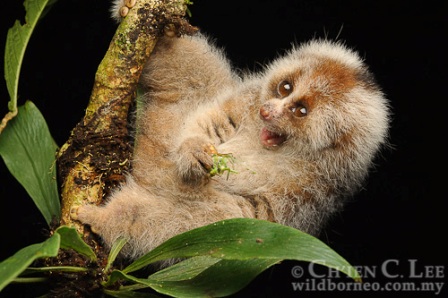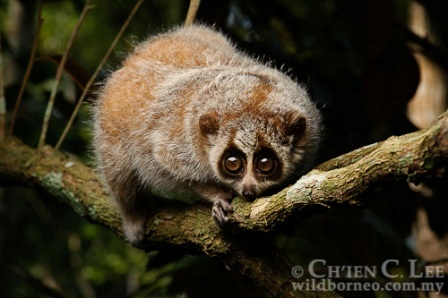
Reproduction
Slow lorises are dioecious (separate males and females), polygamous, and reproduce all year round. At the age of 17-21 months, females are sexually mature and able to reproduce. The males can reproduce as early as 10 months.

The mating duration of slow lorises is about 3-7 minutes on
average. Following conception, there is about a 6 month gestation
period (average is 191 days) followed by delivery of usually only
one, possibly two, offspring. These offspring are placental and are
completely developed by the time they are born. There is about a 16
month span that takes place between each birth in a female loris.
A slow loris is born with its eyes open and already has the
strength and ability to hold onto branches. Following birth, it will
stay with its mother everyday for about 7 weeks. The baby slow loris
clings to the stomach of the mother wherever she goes, except for
when she is searching for food. When the mother goes out in search
of food, she cleans her babies first. This is not a normal cleaning
though; venom from the mother mixes with saliva and gets spread on
the young, which will keep them safe if a predator finds them.
 It will nurse for about 6 months, but it is able to eat
solid food within 4 weeks following birth. Infants grow and can
crawl through the trees by the age of 2 weeks.
It will nurse for about 6 months, but it is able to eat
solid food within 4 weeks following birth. Infants grow and can
crawl through the trees by the age of 2 weeks.
In less that a year, an adolescent slow loris is able to fend for itself and has not developed any sexual dimorphism (differences between genders) by weight.
As a loris grows older, it can show some sexual dimorphism with
males being slightly heavier than the females. On average,
Nycticebus coucang grow to be about 15 inches long, have 1 inch
vestigial tails, and can weight about 3 pounds. They have the
ability to live to 20 years of age, and can slightly exceed that age
in captivity.
To see how this organism interacts with other animals, see Interactions!
To see how other organisms reproduce, see MultipleOrganisms.net!
Back to Homepage